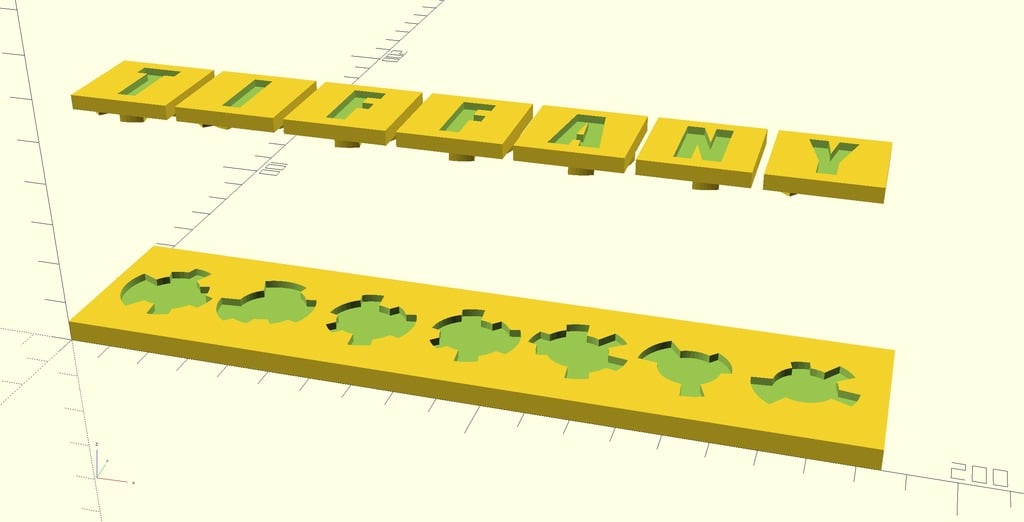
Kids' learn-your-name puzzle (revision 2)
thingiverse
A Customizable Puzzle That Focuses on Letters, Not Shapes of Pegs My goal is to create a puzzle where players focus on finding the right letters rather than identifying the shapes of pegs, as it's challenging to distinguish between them. I have no background or experience to back up this claim; it's simply my hope. The pegs are divided into three layers: - A cube with a missing letter. - A solid cube. - A unique random combination that fits perfectly into the slot on the board. By default, the combination pattern has 12 sectors, each with three different heights. This results in 3^12 = 531441 possible combinations. The board is simply a cube where the combination of each letter of the text has been removed. The board could be made more visually appealing. Unless your daughter's name is Tiffany, you'll likely want to customize this puzzle. Here's how to use it: 1. Open the SCAD in customizer / openSCAD / etc and adjust the **board_size** and **text** variables. If you have a long text, you may need to tweak **font_size** and **peg_size** as well. Make sure the pegs aren't larger than the board. 2. When you're happy with your adjustments, copy the output after "COMBINATIONS-DUMP" and paste that into the variable **preset_combinations** . This will cause the combination of the pegs to remain static rather than being randomly generated. 3. Set mode to "boards", "pegs", or "letters," and for each of them create a model/STL file for printing. Letters are optional; they should probably be printed in a different color filament, or better yet, leave the peg letters hollow. Note: Unfortunately, there's no way to view the `echo()` outputs in the Customizer. Below is an example value to use for **preset_combinations** (you'll need exactly one vector per letter in your text). You can use this if you want to generate the different parts with matching combinations from Customizer. [[0, 2, 1, 0, 0, 2, 0, 0, 1, 2, 2, 2], [0, 2, 2, 2, 0, 1, 1, 0, 1, 2, 1, 1], [0, 2, 0, 1, 2, 1, 1, 2, 2, 0, 1, 2], [1, 1, 2, 2, 2, 0, 1, 0, 0, 1, 2, 1], [0, 2, 0, 2, 2, 2, 2, 1, 1, 2, 2, 0], [1, 1, 0, 1, 2, 2, 0, 2, 2, 2, 2, 1], [1, 0, 0, 1, 0, 1, 0, 1, 1, 1, 0, 0]] Note: The mode "board_with_pegs" is probably not what you want for printing. However, it's possible to print it with internal supports enabled (that is between the board and the pegs). If you'd like the challenge. Revision 2 (2018-08-19): * The peg-to-slot tolerance is fixed after I have learned about `offset()`. * Boards can now be extended with each other by setting `board_ext_edges` for left, right, front, back to either m (male) or f (female). This allows for long texts to be separated and printed in multiple rounds. * `peg_size[2]` (the Z size of the pegs) is now a vector of 3 heights: the height of the extruded letter, the height of the solid, the height of the combination. This allows a deeper combination without using a lot of plastic on the letter. Note: I have printed this design many times now to try to understand what tolerances to use. What is currently in the code might be specific to Ender-3, ABS and probably slicer settings as well. I can try to help if you have trouble but experimentation may be required. Note: Some complicated stuff happens if you configure overlapping extension edges. Apart from some stray geometry which a slicer will probably clean up, it actually works. For example, a female left and front should allow connections in both directions in the conflicting corner.
With this file you will be able to print Kids' learn-your-name puzzle (revision 2) with your 3D printer. Click on the button and save the file on your computer to work, edit or customize your design. You can also find more 3D designs for printers on Kids' learn-your-name puzzle (revision 2).
